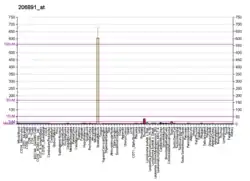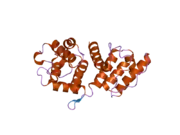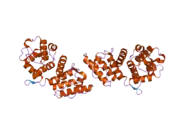Alpha-actinin-3
Alpha-actinin-3, also known as alpha-actinin skeletal muscle isoform 3 or F-actin cross-linking protein, is a protein that in humans is encoded by the ACTN3 gene (named sprinter gene, speed gene or athlete gene) located on chromosome 11. All people have two copies (alleles) of this gene.[3][4]
Alpha-actinin is an actin-binding protein with multiple roles in different cell types. This gene expression is limited to skeletal muscle. It is localized to the Z-disc and analogous dense bodies, where it helps to anchor the myofibrillar actin filaments.[5]
Fast versus slow twitch muscle fibers
Skeletal muscle is composed of long cylindrical cells called muscle fibers. There are two types of muscle fibers, slow twitch or muscle contraction (type I) and fast twitch (type II). Slow twitch fibers are more efficient in using oxygen to generate energy, while fast twitch fibers are less efficient. However, fast twitch fibers fire more rapidly, allowing them to generate more power than slow twitch (type I) fibers. Fast twitch fibers and slow twitch fibers are also called white muscle fibers and red muscles fibers, respectively. The alpha-actinin-3 protein is found in type II muscle fibers.
Alleles
An allele (rs1815739; 577X) has been identified in the ACTN3 gene which results in a deficiency of alpha-actinin-3 in the individuals.[6][7] The X homozygous genotype (ACTN3 577XX) is caused by a C to T transition in exon 16 of the ACTN3 gene, which causes a transformation of an arginine base (R) to a premature stop codon (X) resulting in the rs1815739 mutation causing no production of the alpha-actinin 3 protein in muscle fibers.[8] The 577XX polymorphism causes no production of alpha-actinin 3 protein which is essential in fast twitch muscle fibers.[8]
It has been speculated that variations in this gene evolved to accommodate the energy expenditure requirements of people in various parts of the world.[6]: 155–156 Over 75% of the persons have one or two copies of ACTN3 577R and have alpha-actinin-3. Homozygous individuals (ACTN3 577XX) have no alpha-actinin-3 (16%-20% of the population),[9][10] but they have a high level of alpha-actinin-2.
Athletes
There is an association between the ACTN3 R577X polymorphism in sprint and powerlifting performance at an elite level (RR and RX variants are better), and appears to be an association with exercise recovery and lower injury risk.[8] It appears that the XX genotype is associated with higher levels of muscle damage and a longer time required for recovery.[8]
See also
References
- GRCh38: Ensembl release 89: ENSG00000248746 - Ensembl, May 2017
- "Human PubMed Reference:". National Center for Biotechnology Information, U.S. National Library of Medicine.
- "ACTN3 - Alpha-actinin-3 - Homo sapiens (Human) - ACTN3 gene & protein". www.uniprot.org. Retrieved 22 April 2022.
- Beggs AH, Byers TJ, Knoll JH, Boyce FM, Bruns GA, Kunkel LM (May 1992). "Cloning and characterization of two human skeletal muscle alpha-actinin genes located on chromosomes 1 and 11". The Journal of Biological Chemistry. 267 (13): 9281–9288. doi:10.1016/S0021-9258(19)50420-3. PMID 1339456.
- "Entrez Gene: ACTN3 actinin, alpha 3".
- Epstein, David (2013). The Sports Gene: Inside the Science of Extraordinary Athletic Performance. Penguin. ISBN 978-1-101-62263-6.
- North KN, Yang N, Wattanasirichaigoon D, Mills M, Easteal S, Beggs AH (April 1999). "A common nonsense mutation results in alpha-actinin-3 deficiency in the general population". Nature Genetics. 21 (4): 353–354. doi:10.1038/7675. PMID 10192379. S2CID 19882092.
- Pickering C, Kiely J (2017). "ACTN3: More than Just a Gene for Speed". Frontiers in Physiology. 8: 1080. doi:10.3389/fphys.2017.01080. PMC 5741991. PMID 29326606.
- Hogarth MW, Houweling PJ, Thomas KC, Gordish-Dressman H, Bello L, Pegoraro E, et al. (January 2017). "Evidence for ACTN3 as a genetic modifier of Duchenne muscular dystrophy". Nature Communications. 8 (1): 14143. Bibcode:2017NatCo...814143H. doi:10.1038/ncomms14143. PMC 5290331. PMID 28139640.
- Seto, Jane T.; Lek, Monkol; Quinlan, Kate G.R.; Houweling, Peter J.; Zheng, Xi F.; Garton, Fleur; MacArthur, Daniel G.; Raftery, Joanna M.; Garvey, Sean M.; Hauser, Michael A.; Yang, Nan; Head, Stewart I.; North, Kathryn N. (2011). "Deficiency of α-actinin-3 is associated with increased susceptibility to contraction-induced damage and skeletal muscle remodeling". Human Molecular Genetics. 20 (15): 2914–2927. doi:10.1093/hmg/ddr196. PMID 21536590. Retrieved 15 February 2022.
- Chan Y, Tong HQ, Beggs AH, Kunkel LM (July 1998). "Human skeletal muscle-specific alpha-actinin-2 and -3 isoforms form homodimers and heterodimers in vitro and in vivo". Biochemical and Biophysical Research Communications. 248 (1): 134–139. doi:10.1006/bbrc.1998.8920. PMID 9675099.
Further reading
- MacArthur DG, North KN (July 2004). "A gene for speed? The evolution and function of alpha-actinin-3". BioEssays. 26 (7): 786–795. doi:10.1002/bies.20061. PMID 15221860. S2CID 19761762.
- Beggs AH, Byers TJ, Knoll JH, Boyce FM, Bruns GA, Kunkel LM (May 1992). "Cloning and characterization of two human skeletal muscle alpha-actinin genes located on chromosomes 1 and 11". The Journal of Biological Chemistry. 267 (13): 9281–9288. doi:10.1016/S0021-9258(19)50420-3. PMID 1339456.
- Yürüker B, Niggli V (February 1992). "Alpha-actinin and vinculin in human neutrophils: reorganization during adhesion and relation to the actin network". Journal of Cell Science. 101. 101 ( Pt 2) (2): 403–414. doi:10.1242/jcs.101.2.403. PMID 1629252.
- Pavalko FM, LaRoche SM (October 1993). "Activation of human neutrophils induces an interaction between the integrin beta 2-subunit (CD18) and the actin binding protein alpha-actinin". Journal of Immunology. 151 (7): 3795–3807. PMID 8104223.
- Chan Y, Tong HQ, Beggs AH, Kunkel LM (July 1998). "Human skeletal muscle-specific alpha-actinin-2 and -3 isoforms form homodimers and heterodimers in vitro and in vivo". Biochemical and Biophysical Research Communications. 248 (1): 134–139. doi:10.1006/bbrc.1998.8920. PMID 9675099.
- North KN, Yang N, Wattanasirichaigoon D, Mills M, Easteal S, Beggs AH (April 1999). "A common nonsense mutation results in alpha-actinin-3 deficiency in the general population". Nature Genetics. 21 (4): 353–354. doi:10.1038/7675. PMID 10192379. S2CID 19882092.
- Nikolopoulos SN, Spengler BA, Kisselbach K, Evans AE, Biedler JL, Ross RA (January 2000). "The human non-muscle alpha-actinin protein encoded by the ACTN4 gene suppresses tumorigenicity of human neuroblastoma cells". Oncogene. 19 (3): 380–386. doi:10.1038/sj.onc.1203310. PMID 10656685.
- Takada F, Vander Woude DL, Tong HQ, Thompson TG, Watkins SC, Kunkel LM, Beggs AH (February 2001). "Myozenin: an alpha-actinin- and gamma-filamin-binding protein of skeletal muscle Z lines". Proceedings of the National Academy of Sciences of the United States of America. 98 (4): 1595–1600. doi:10.1073/pnas.041609698. PMC 29302. PMID 11171996.
- Bang ML, Mudry RE, McElhinny AS, Trombitás K, Geach AJ, Yamasaki R, et al. (April 2001). "Myopalladin, a novel 145-kilodalton sarcomeric protein with multiple roles in Z-disc and I-band protein assemblies". The Journal of Cell Biology. 153 (2): 413–427. doi:10.1083/jcb.153.2.413. PMC 2169455. PMID 11309420.
- Mills M, Yang N, Weinberger R, Vander Woude DL, Beggs AH, Easteal S, North K (June 2001). "Differential expression of the actin-binding proteins, alpha-actinin-2 and -3, in different species: implications for the evolution of functional redundancy". Human Molecular Genetics. 10 (13): 1335–1346. doi:10.1093/hmg/10.13.1335. PMID 11440986.
- Burgueño J, Blake DJ, Benson MA, Tinsley CL, Esapa CT, Canela EI, et al. (September 2003). "The adenosine A2A receptor interacts with the actin-binding protein alpha-actinin". The Journal of Biological Chemistry. 278 (39): 37545–37552. doi:10.1074/jbc.M302809200. PMID 12837758.
- Clarkson PM, Devaney JM, Gordish-Dressman H, Thompson PD, Hubal MJ, Urso M, et al. (July 2005). "ACTN3 genotype is associated with increases in muscle strength in response to resistance training in women". Journal of Applied Physiology. 99 (1): 154–163. doi:10.1152/japplphysiol.01139.2004. PMID 15718405. S2CID 23205110.
- Franzot G, Sjöblom B, Gautel M, Djinović Carugo K (April 2005). "The crystal structure of the actin binding domain from alpha-actinin in its closed conformation: structural insight into phospholipid regulation of alpha-actinin". Journal of Molecular Biology. 348 (1): 151–165. doi:10.1016/j.jmb.2005.01.002. PMID 15808860.
- Clarkson PM, Hoffman EP, Zambraski E, Gordish-Dressman H, Kearns A, Hubal M, et al. (August 2005). "ACTN3 and MLCK genotype associations with exertional muscle damage". Journal of Applied Physiology. 99 (2): 564–569. doi:10.1152/japplphysiol.00130.2005. PMID 15817725.
- Asanuma K, Kim K, Oh J, Giardino L, Chabanis S, Faul C, et al. (May 2005). "Synaptopodin regulates the actin-bundling activity of alpha-actinin in an isoform-specific manner". The Journal of Clinical Investigation. 115 (5): 1188–1198. doi:10.1172/JCI23371. PMC 1070637. PMID 15841212.
- Niemi AK, Majamaa K (August 2005). "Mitochondrial DNA and ACTN3 genotypes in Finnish elite endurance and sprint athletes". European Journal of Human Genetics. 13 (8): 965–969. doi:10.1038/sj.ejhg.5201438. PMID 15886711.
- Triplett JW, Pavalko FM (November 2006). "Disruption of alpha-actinin-integrin interactions at focal adhesions renders osteoblasts susceptible to apoptosis". American Journal of Physiology. Cell Physiology. 291 (5): C909–C921. doi:10.1152/ajpcell.00113.2006. PMID 16807302. S2CID 21854341.
External links
- Human ACTN3 genome location and ACTN3 gene details page in the UCSC Genome Browser.





